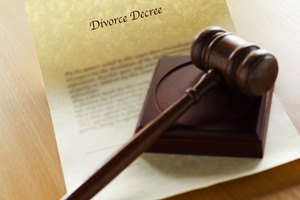How to File for Divorce in Long Beach, California
By John Stevens J.D.

Stockbyte/Stockbyte/Getty Images
Not only is it possible to handle a divorce on your own in California, it is actually common for one spouse to do so without the assistance of an attorney. Oftentimes, the divorce process is fairly straightforward if the parties are not represented by an attorney; however, unrepresented parties are free to hire an attorney if the need arises. Los Angeles county maintains several courthouses to serve different geographical areas, including a courthouse in Long Beach. Although the forms used to file for divorce are uniform throughout the state, you must satisfy two important prerequisites to file in Long Beach.
The Divorce Process in California
A divorce is initiated in California by the filing of a Petition. The Petition requests the court to grant a divorce and includes the terms of the divorce, such as the allocation of any property owned by the spouses, income and expenses of each spouse, and custody and visitation requests for any minor children the spouses have together. The spouse who files the Petition is referred to as the Petitioner. After filing the Petition, the Petitioner must have a copy of the Petition served on the other spouse. The Petitioner is not permitted to serve the opposing spouse, called the Respondent, with the Petition. However, any other person at least 18 years old can serve the Petition. The Respondent has 30 days in which to file paperwork opposing the facts alleged in the Petition. This paperwork is called the Response. If the Respondent does not file a Response within 30 days, the Petitioner can file a second set of paperwork asking for a default judgment. A default judgment means the court grants the divorce without hearing from the other party. If the Respondent agrees with the terms of the Petition, the Respondent is not required to file a Response. Instead, the Petitioner can file the default judgment papers and no court date is set. If the Respondent does file a response, the case is set for trial to determine the disposition of the issues on which the divorcing parties disagree.
Jurisdiction and Venue
There are two prerequisites to filing for divorce in California. The first is called jurisdiction. Jurisdiction refers to a court’s power to hear a case. For a court in California to hear a divorce case, at least one spouse must have lived in California for at least six months prior to the filing of the Petition. The second prerequisite is called venue. Whereas jurisdiction refers to the power of a court in California to hear a case, venue refers to which county within California can hear the case. The Petitioner may file the Petition in any county where at least one spouse has lived for at least the last three months. These prerequisites mean that at least one spouse must have lived in California for at least the last six months before the filing of the Petition and, because Long Beach is located within Los Angeles county, at least one spouse must have lived within Los Angeles county for at least the last three months.
Acquiring and Completing the Divorce Forms
The forms used to file for divorce are available at the court clerk’s office at no cost. The court clerk’s office is located on the second floor of the Long Beach courthouse. The courthouse is located at 415 West Ocean Boulevard, Long Beach, CA 90802. The forms feature a fill-in-the-blank format and are fairly straightforward to complete. The divorce forms package includes all the possible forms necessary to file for divorce. Review each form carefully, as you may or may not need each one, and the court clerks will not give you legal advice regarding the forms. For example, if you and your spouse do not have minor children together, you do not need the forms titled “Child Custody and Visitation Application” or “Children’s Holiday Schedule Attachment.”
Filing the Forms
You will need three copies of your divorce Petition to present to the court clerk for filing. Make two photocopies of your original. The clerk will accept and keep your original copy first. Ask the clerk to “conform” your remaining two copies. The court will stamp them and return them to you. One copy is for your records. The other copy is the copy your spouse is to receive. After the clerk processes your papers, the clerk will ask for the filing fee. The filing fee is subject to change annually, so you may want to call the Family Law Facilitator’s Office at 562-491-6432 to determine the current fee. If you cannot afford the fee, ask the clerk or Family Law Facilitator’s Office for a fee waiver application form. Complete the income and expense information requested on the form and present the completed form to the clerk.
References
- Practice Under the California Family Code; Continuing Education of the California Bar
- California Courts: Filing for Divorce or Separation Forms
Writer Bio
John Stevens has been a writer for various websites since 2008. He holds an Associate of Science in administration of justice from Riverside Community College, a Bachelor of Arts in criminal justice from California State University, San Bernardino, and a Juris Doctor from Whittier Law School. Stevens is a lawyer and licensed real-estate broker.